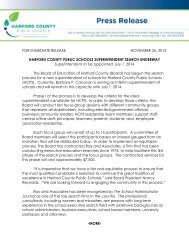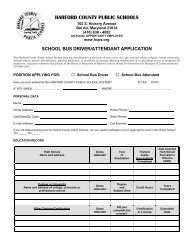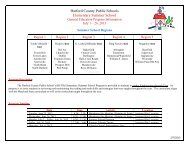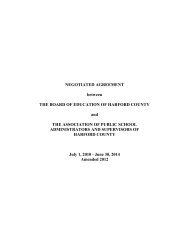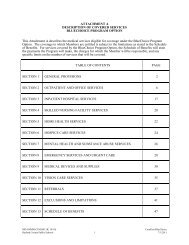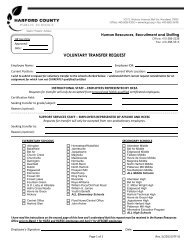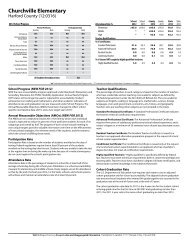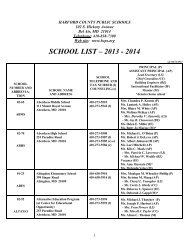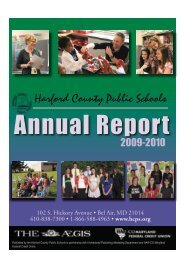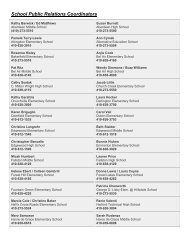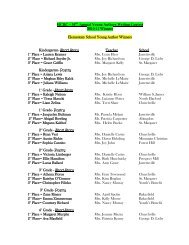Parent Handbook - Harford County Public Schools
Parent Handbook - Harford County Public Schools
Parent Handbook - Harford County Public Schools
You also want an ePaper? Increase the reach of your titles
YUMPU automatically turns print PDFs into web optimized ePapers that Google loves.
Registering Your Child For School<br />
Children moving into the community during the school year should register as soon as possible.<br />
Application for prekindergarten and kindergarten registration for students takes place on the<br />
first Friday in May. Other elementary students and secondary students can be registered at any<br />
time which is convenient to the school and the parents/guardians. <strong>Parent</strong>s/guardians are asked<br />
to call the school to arrange for appointments for registering their children. It is hoped that this<br />
registration will occur as early as possible during the summer.<br />
All students should be enrolled at the school that they will attend. <strong>Parent</strong>s/guardians who are<br />
unable to apply for prekindergarten or register kindergarten children at the scheduled time in<br />
May should call the school for an appointment.<br />
At the time of registration, parents/guardians are required to present the child’s birth certificate,<br />
immunization record, and proof of residency. In addition, a copy of a current income tax return<br />
is required with all prekindergarten applications. All students must meet State immunization<br />
requirements before they may be admitted to school.<br />
A record of a physical examination is required for students who are entering a Maryland public<br />
school for the first time - no longer than nine months prior to entering or within six months after<br />
entering.<br />
Students entering prekindergarten, kindergarten, and first grade must provide a lead testing<br />
certificate. Students living in designated zip codes must provide evidence of blood lead testing.<br />
Immunization Compliance Criteria For Maryland <strong>Schools</strong><br />
The State of Maryland has established immunization requirements for all students entering or<br />
enrolled in Maryland schools for the 2011-2012 school year.<br />
Requirements to achieve complete immunization status include the following:<br />
• Diphtheria, tetanus, and pertussis (whooping cough), (DTaP, DTP) – 4 doses vaccine<br />
for all students entering PreK-12th grade. If DT is given in place of DTP or DTaP, a<br />
physician documented medical contraindication if required.<br />
• Polio vaccine - three (3) doses for all students less than 18 years of age or proof of<br />
immunity by positive blood test.<br />
• Measles - two (2) doses of measles vaccine received on or after student’s first birthday,<br />
or proof of immunity by positive blood test for students entering K-12th grade. Preschool<br />
students under 60 months of age require one dose of measles; preschool students 60<br />
months of age or older require two (2) doses of measles vaccine.<br />
• One (1) dose of rubella vaccine on or after the student’s first birthday, or proof of<br />
immunity by a positive blood test for students entering K-12th grade. Preschool students<br />
60 months or older require two (2) doses of rubella vaccine.<br />
• One (1) dose of mumps vaccine on or after the student’s first birthday or proof of<br />
immunity through a positive blood test for students entering K-12th grade. Preschool<br />
students 60 months of age or older require two (2) doses of mumps vaccine.<br />
• Varicella: one (1) dose required for students under 13 years of age administered on<br />
or after student’s first birthday; or two (2) doses required for previously unvaccinated<br />
students 13 years of age and older. History of chicken pox documented by a health care provider<br />
including month and year of disease or a positive blood test will be accepted as proof in lieu of<br />
vaccination.<br />
• Hepatitis B vaccine - three (3) doses or a positive blood test for students entering PreK—12th grade.<br />
Students enrolled in preschool programs must also:<br />
• Have received one (1) dose of Pneumococcal vaccine (PCV7, PCV 13, Prevnar) if they are under 60<br />
months of age.<br />
• Have received Haemophilus influenza- type b vaccine (Hib) if they are under 60 months of age. At least<br />
one (1) dose of Hib must be administered on or after the first birthday.<br />
(Upon record review a vaccine dose given less than or equal to four (4) days before the minimum interval<br />
or age may be counted as valid.) Official documentation is recorded on the Maryland Immunization Certificate,<br />
DHMH 896. This form is available from the schools. If you have documentation from another source, please<br />
consult with the school nurse.<br />
Proof of Residency<br />
The following are the types of acceptable documentation:<br />
• settlement papers<br />
• rental lease agreement<br />
• utility bill<br />
*All documents must be dated within three (3) months of registration.<br />
Examples of documents that are unacceptable as proof of residency:<br />
• driver’s license<br />
• property tax bill<br />
In instances where the owner/leasee of the home in which the student lives is not the parent/guardian of the<br />
student, the owner/leasee of the home will provide a signed, notarized affidavit verifying that the student and<br />
student’s parent/guardian reside at that address.<br />
Reporting Student Progress<br />
Pupil progress is formally reported to parents in November, February, April, and June (at the end of the<br />
school year). In addition, teachers communicate with parents informally by means of conferences, letters, and<br />
telephone calls. The Edline online system is used to communicate progress of secondary students through the<br />
use of an assigned PIN number.<br />
No report card is issued in November to elementary school children. Instead, a conference is scheduled for<br />
parents and teachers so that they may discuss each child’s rate of progress, expected standards for learning<br />
and discipline, school curriculum, and school goals. Elementary school students receive report cards in<br />
February, April, and June. Students in grades six through 12 receive report cards at the end of each of the four<br />
marking periods.<br />
Students in prekindergarten, kindergarten, and grades one and two receive a non-graded report card. In<br />
grades three, four and five, letter grades are used to indicate the level of student progress in integrated<br />
language arts, social studies, science, and mathematics. Handwriting, art, music, media, and physical<br />
education, as well as 17 habits and attitudes listed on the report card, are marked S (satisfactory) or N (needs<br />
improvement). Progress at the secondary level is recorded by means of the letter grades A, B, C, D, or E.<br />
18



